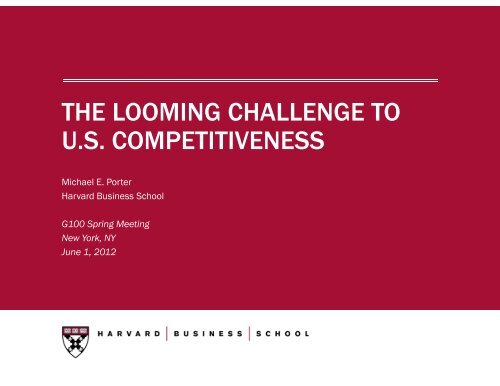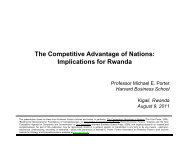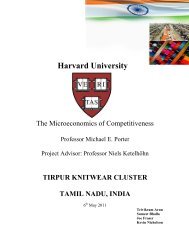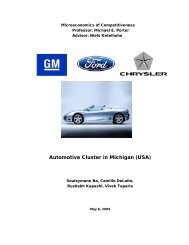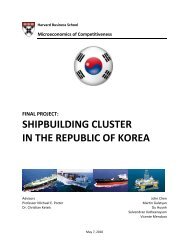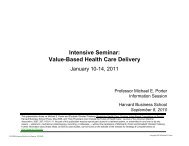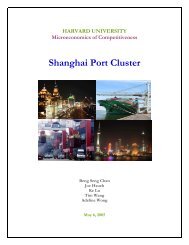the looming challenge to us competitiveness - Institute for Strategy ...
the looming challenge to us competitiveness - Institute for Strategy ...
the looming challenge to us competitiveness - Institute for Strategy ...
Create successful ePaper yourself
Turn your PDF publications into a flip-book with our unique Google optimized e-Paper software.
THE LOOMING CHALLENGE TO<br />
U.S. COMPETITIVENESS<br />
Michael E. Porter<br />
Harvard B<strong>us</strong>iness School<br />
G100 Spring Meeting<br />
New York, NY<br />
June 1, 2012
WHAT IS COMPETITIVENESS?<br />
The United States is a competitive location <strong>to</strong> <strong>the</strong> extent that firms operating in<br />
<strong>the</strong> U.S. are able <strong>to</strong> compete successfully in <strong>the</strong> global economy while supporting<br />
high and rising wages and living standards <strong>for</strong> <strong>the</strong> average American<br />
• Competitiveness depends on improving long-run productivity per working<br />
age citizen<br />
– Not low wages or a cheap dollar<br />
– Not job creation <strong>for</strong> its own sake<br />
• Competitiveness is not a zero-sum game among countries<br />
U.S. COMPETITIVENESS PROJECT 2
3%<br />
DISTURBING TRENDS<br />
ROLLING 10-YEAR COMPOUND ANNUAL GROWTH RATE IN TOTAL NUMBER OF<br />
U.S. PRIVATE NONFARM EMPLOYEES, 1975-2011<br />
1975-2001<br />
AVERAGE: 2.11%<br />
2%<br />
1%<br />
0%<br />
-1%<br />
1975 1980 1985 1990 1995 2000 2005 2010<br />
Source: Bureau of Labor Statistics, author’s calculations.<br />
U.S. COMPETITIVENESS PROJECT 3
DISTURBING TRENDS<br />
U.S. LABOR FORCE PARTICIPATION RATE, 1948-2011<br />
78%<br />
Labor <strong>for</strong>ce participation<br />
74%<br />
70%<br />
66%<br />
LABOR FORCE<br />
PARTICIPATION<br />
RATE<br />
POPULATION AGED<br />
16-64 INVOLVED IN<br />
THE WORKFORCE<br />
62%<br />
1948 1957 1966 1975 1984 1993 2002 2011<br />
Source: Bureau of Labor Statistics.<br />
U.S. COMPETITIVENESS PROJECT 4
WHAT ARE THE CAUSES?<br />
U.S. trajec<strong>to</strong>ry<br />
40%<br />
20%<br />
0%<br />
-20%<br />
-40%<br />
-60%<br />
-80%<br />
Weakness but Improving<br />
TAX CODE<br />
POLITICAL<br />
SYSTEM<br />
MACRO<br />
POLICY<br />
LEGAL<br />
FRAMEWORK<br />
REGULATION<br />
K-12 EDUCATION<br />
SYSTEM<br />
Weakness and Deteriorating<br />
LOGISTICS<br />
INFRASTRUCTURE<br />
Strength and Improving<br />
COMMUNICATIONS<br />
INFRASTRUCTURE<br />
UNIVERSITIES<br />
ENTREPRENEURSHIP<br />
FIRM MANAGEMENT<br />
INNOVATION<br />
PROPERTY RIGHTS<br />
CLUSTERS<br />
CAPITAL MARKETS<br />
SKILLED LABOR<br />
FLEXIBILITY IN<br />
HIRING AND<br />
FIRING<br />
Strength but Deteriorating<br />
-100%<br />
-60% -40% -20% 0% 20% 40% 60% 80% 100%<br />
Current U.S. position<br />
U.S. COMPETITIVENESS PROJECT 5
POLICY NO-BRAINERS FOR U.S. COMPETITIVENESS<br />
1. Ease <strong>the</strong> immigration of highly skilled individuals, starting with international<br />
graduates of U.S. universities<br />
2. Simplify <strong>the</strong> corporate tax code with lower statu<strong>to</strong>ry rates and no loopholes<br />
3. Create an international taxation system <strong>for</strong> multinational companies that is<br />
consistent with practices in o<strong>the</strong>r leading countries, eliminates <strong>the</strong> need <strong>for</strong> tax<br />
havens, and encourages repatriation of profits<br />
4. Aggressively address dis<strong>to</strong>rtions in <strong>the</strong> international trading system in o<strong>the</strong>r<br />
countries that disadvantage <strong>the</strong> United States, <strong>us</strong>ing established international<br />
institutions<br />
5. Find simpler and faster ways <strong>to</strong> regulate b<strong>us</strong>iness and <strong>the</strong> financial markets,<br />
foc<strong>us</strong>ing on outcomes instead of costly reporting and compliance <strong>for</strong> every b<strong>us</strong>iness<br />
6. Enact policies that accelerate <strong>the</strong> responsible development and conversion <strong>to</strong><br />
natural gas, as an interim, cleaner and low-cost domestic energy source<br />
7. Create a s<strong>us</strong>tainable federal budget through a combination of revenue increases<br />
weighted <strong>to</strong>wards reducing deductions, efficiencies in entitlement programs, and<br />
updating of spending priorities, embodying a compromise such as Simpson-Bowles<br />
U.S. COMPETITIVENESS PROJECT 6
THE ROLE OF BUSINESS IN COMPETITIVENESS<br />
ACTION AGENDA<br />
Improving skills<br />
• Create or expand an apprentice program <strong>to</strong> train workers <strong>to</strong> be employable by<br />
company and o<strong>the</strong>rs<br />
• Create or expand a training program <strong>to</strong> upgrade <strong>the</strong> skills and productivity of current<br />
or prospective employees<br />
• Partner with a community college, technical school, or university <strong>to</strong> align its<br />
curriculum with <strong>the</strong> needs of b<strong>us</strong>iness, and commit <strong>to</strong> hire a number of its graduates<br />
Upgrading supporting ind<strong>us</strong>tries<br />
• Identify and increase sourcing from capable local suppliers<br />
• Men<strong>to</strong>r local suppliers <strong>to</strong> upgrade <strong>the</strong>ir capabilities and make <strong>the</strong>m more attractive<br />
partners<br />
• Join consortia that help small companies access procurement contracts<br />
Supporting innovation and entrepreneurship<br />
• Participate in research collaboratives in company’s field that build technologies and<br />
b<strong>us</strong>inesses of <strong>the</strong> future<br />
• Invest in or incubate promising startups related <strong>to</strong> company’s b<strong>us</strong>iness<br />
U.S. COMPETITIVENESS PROJECT 7
Locating in <strong>the</strong> U.S.<br />
THE ROLE OF BUSINESS IN COMPETITIVENESS<br />
ACTION AGENDA<br />
• Move back <strong>to</strong> <strong>the</strong> U.S. b<strong>us</strong>iness activities that can be productive here<br />
Bolstering cl<strong>us</strong>ter and regional development<br />
• Participate in a cl<strong>us</strong>ter <strong>competitiveness</strong> initiative in your field<br />
• Participate in a regional <strong>competitiveness</strong> initiative in your region<br />
Shifting <strong>the</strong> b<strong>us</strong>iness-government relationship<br />
• Advocate b<strong>us</strong>iness-wide improvements ra<strong>the</strong>r than lobby <strong>for</strong> special interests<br />
U.S. COMPETITIVENESS PROJECT 8


